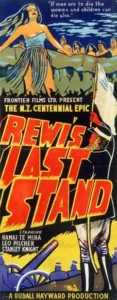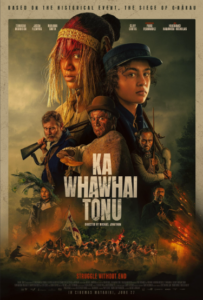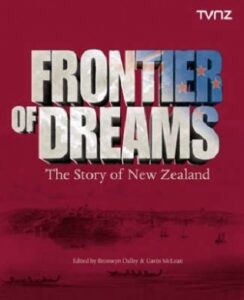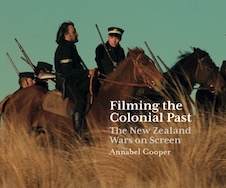 One interesting source for the New Zealand Wars, sometimes overlooked, is movies and documentaries. Over the years, there have been some very good films about aspects of the wars, whether they be movies, TV series or documentaries.
One interesting source for the New Zealand Wars, sometimes overlooked, is movies and documentaries. Over the years, there have been some very good films about aspects of the wars, whether they be movies, TV series or documentaries.
This section highlights a range of recent screen adaptations of the New Zealand Wars. The most indispensable and interesting book on this topic is Annabel Cooper, Filming the Colonial Past. The New Zealand Wars on Screen, Otago University Press, Dunedin, 2018.
THE DEADLANDS 2014
The latest movie by acclaimed New Zealand director Toa Fraser, The Dead Lands is totally in Māori, appropriately since the action occurs in the days before Europe encountered New Zealand. The movie was released in New Zealand in 2014. James Rolleston (Hongi) and Lawrence Makoare (The Warrior) are terrific in their respective roles as an aggrieved young warrior seeking the guidance of a reclusive but violent elder, in a matter of tribal revenge.  Te Kohe Tuhaka is terrific as Wirepa, almost stealing the movie from his better-known cast members. Xavier Horan also stars as Rangi, with Raukura Turei (right) as Mehe, a wahine toa – woman warrior – who has the audacity to confront The Warrior, with tragic results.
Te Kohe Tuhaka is terrific as Wirepa, almost stealing the movie from his better-known cast members. Xavier Horan also stars as Rangi, with Raukura Turei (right) as Mehe, a wahine toa – woman warrior – who has the audacity to confront The Warrior, with tragic results.
Veteran and accomplished Māori actors George Henare and Rena Owen also star in this movie. The movie did fairly well in New Zealand, but it is a terrific watch – though, be wary, it is also quite violent, though these days, with quick-editing, you don’t get to see the worst of it. Quick-cutting (for want of a better term) was used to good effect by Ridley Scott in ‘Gladiator’, though it does tend to ritualize (or sanitize) violence, which can be a little troubling. The movie also depicts a Māori world given to unrelieved warfare, warfare as the modus through which all tribal and personal relations are mediated.
Some scholars agree with this view, like Māori jurist Sir Eddie Durie, in his masterful study, Māori Custom Law (1994). Dr Angela Ballara has also argued that ‘warfare was endemic in Māori society’, though she has equally written of peace-making protocols that also existed, alongside the Māori propensity for war.
UTU 1984
The movie UTU was first released on 27 June 1984. This was an international release, but was generally critiqued as too long and meandering, with, for example, its chief protagonist Te Wheke taking time out to read Shakespeare. However, the movie did have its moments and was received well in New Zealand.
The movie was however recut into a much shorter and crisper version, for international release, in particular using flashbacks to retell its vast and interesting story. Flashbacks don’t often work in movies – they slow down the pacing – but, in this new version of UTU, they worked quite well. UTU was directed by New Zealand Director Geoff Murphy who also wrote the screenplay with actor and writer, Keith Aberdein.
The film starred Anzac Wallace and Wi Kuki Kaa as brothers on opposite sides of the colonial divide. The story is set in the 1870s, as the New Zealand Wars are coming to an end. Te Wheke (played by Wallace) comes upon his home village, shortly after it’s been attacked by the Armed Constabulary. Grief stricken, Te Wheke embarks upon a campaign of destruction and murder of Pākehā settlers. The Armed Constabulary is soon on his tail, assisted by his retiring brother, Wiremu (played by Kaa).
The story is set in the 1870s, as the New Zealand Wars are coming to an end. Te Wheke (played by Wallace) comes upon his home village, shortly after it’s been attacked by the Armed Constabulary. Grief stricken, Te Wheke embarks upon a campaign of destruction and murder of Pākehā settlers. The Armed Constabulary is soon on his tail, assisted by his retiring brother, Wiremu (played by Kaa).
Also assisting the Constabulary, as it hunts Te Wheke through the bush, is settler-farmer Williamson (played by Bruno Lawrence) whose wife has died at the (if, this time, unwitting) hands of Te Wheke.
 CROOKED EARTH 2001
CROOKED EARTH 2001
This movie isn’t quite a New Zealand Wars movie; in fact, it’s set in the 1990s. But it bears a lot of resemblance to the earlier movie UTU, released in 1984. In fact, Crooked Earth seems to be a modern retelling of UTU. Crooked Earth, released in 2001, was directed by Sam Pilsbury with screenplay by popular New Zealand author Greg McGee. The movie’s substantial Māori cultural content was provided by Māori broadcaster and language expert, Waihoroi Shortland. The movie also showcases some of the best Māori acting talent around these days – Temuera Morrison, Lawrence Makoare, George Henare, Nancy Brunning and Jamie Passier-Armstrong. DJ and broadcasting personality Quinton Hita also appears.
The film concerns a battle of wills between two brothers, one of whom must assume the mantle of family leadership, and with it a substantial greenstone mere, following the death of their father. The older brother, Will (Tem Morrison) is reluctant. He has been posted overseas with the New Zealand Army. Now dishonorably discharged, he returns home, and wants nothing more than peace and quiet. The younger brother, Kahu (Makoare) seizes the chance to ‘assume the mantle’, against the better judgement of the wider community, of which both Will and Kahu are an essential part. This is because Kahu is driven by rage against Pākehā and intends to use his newly acquired family leadership as the basis for an attack upon local Treaty negotiations and commercial activities.
The most telling line of the movie is uttered by Kahu, when he meets/confronts brother Will at their father’s tangi (funeral). The question is – which brother will now assume the mantle of leadership? As everyone watches, Kahu picks up the greenstone mere, which represents the mantle of leadership. Will says quietly – ‘oh you think you can carry that thing son?’. Kahu replies – ‘it’s up to you or me bro’. Will replies, ‘I came home to bury the old man, not to take his place.’ Kahu then picks up the greenstone mere – ‘then all you gonna need is a shovel then eh ..’ It’s quite a line .. you can actually watch the whole scene on You Tube – Scene from Crooked Earth. When Will is later prevailed upon to step up, as Kahu starts to run riot, and contest his rightful place as leader (as older brother), then sadly a violent showdown between the brothers, Will and Kahu, becomes inevitable.
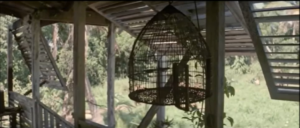 Brother against brother – ‘Brother against brother’ is a device used in movies quite often, in order to resolve a movie’s central tension, providing a neat resolution. But it’s an unsatisfactory device for two reasons. Firstly, it relies on the ‘redemption in death’ trope that is common in mainstream movies – essentially, you need to kill-off the hero, for the movie to ‘work’. SPOILERS AHEAD! Saving Private Ryan and A Thin Red Line (right) are good recent examples where the main ‘hero’ – or primary narrative focus – both die in battle. Secondly, ‘brother on brother’ reduces an incredibly complex narrative to what is essentially a family dispute, however egregious that dispute might be.
Brother against brother – ‘Brother against brother’ is a device used in movies quite often, in order to resolve a movie’s central tension, providing a neat resolution. But it’s an unsatisfactory device for two reasons. Firstly, it relies on the ‘redemption in death’ trope that is common in mainstream movies – essentially, you need to kill-off the hero, for the movie to ‘work’. SPOILERS AHEAD! Saving Private Ryan and A Thin Red Line (right) are good recent examples where the main ‘hero’ – or primary narrative focus – both die in battle. Secondly, ‘brother on brother’ reduces an incredibly complex narrative to what is essentially a family dispute, however egregious that dispute might be.
In both UTU and CROOKED EARTH, it all comes down to a confrontation between brothers who are on competing sides, it’s an unfortunate variant of ‘good versus evil’ because, in both movies, the ‘good’ brother kills the ‘bad’ brother, thus ensuring that good prevails over evil. SPOLERS AHEAD! In UTU, the good brother, Wiremu, who is an Armed Constabulary Officer, executes his brother Te Wheke, the rebel, thus resolving the central tension of the movie, which is the ultimate defeat of Māori on the battlefield. Who better to resolve this tension than one of the family, a whānau that now bears the cross for all of the egregious complexity of colonization. In CROOKED EARTH, the brother who stands for law and order with Māori remaining conciliatory, Will, ends up shooting Kahu, who is the renegade brother who stands against the ‘sham’ of Treaty settlements. It’s a device – brother on brother (or sibling on sibling) – that is used more frequently in movies than you might realise (eg THE WIND THAT SHAKES THE BARELY, an excellent movie about the Irish Troubles starring Cillian Murphy and directed by Ken Loach).
[Danny would like to thank filmmaker and academic Dr Ocean Mercier of Māori Studies, Victoria University, Wellington, for our many interesting discussions on this topic].
FRONTIER TALES 2002
Frontier Tales was a documentary filmed in Auckland, in 2002. The interiors and interviews were shot at the Auckland Museum, with the exteriors filmed on a secluded film set just west of Auckland. The programme was produced by Kay Elmers and Ray Lillis, who also wrote the script on which the episode was based. The episode was first screened on TV One, on 6 February 2003 (Waitangi Day) at 5pm, running for an hour before the news at 6pm. Frontier Tales was intended as the first of a series of documentaries based on the works of New Zealand historian James Cowan (below), whose prodigious New Zealand Wars was published in two volumes, in 1922 and 1924. This particular episode, though, was the only one made.
 The programme’s presenter was Pio Terei, then regarded as a very successful Māori comedian. Fronting Frontier Tales cast Pio in a slightly different role. Given his enormous talent, the ‘casting’ of Pio worked really well; he was also a delightful person to work with. The other ‘cast member’ was Dr Danny Keenan, who, in discussions with Pio, provided on screen overviews of the histories underlying the stories of James Cowan.
The programme’s presenter was Pio Terei, then regarded as a very successful Māori comedian. Fronting Frontier Tales cast Pio in a slightly different role. Given his enormous talent, the ‘casting’ of Pio worked really well; he was also a delightful person to work with. The other ‘cast member’ was Dr Danny Keenan, who, in discussions with Pio, provided on screen overviews of the histories underlying the stories of James Cowan.
Frontier Tales was produced with a budget of $124,977 by Pipi Productions, Auckland.
OTHER NOTABLE SCREEN PRESENTATIONS OF THE NZ WARS
(Place your cursor on the image for brief details).





